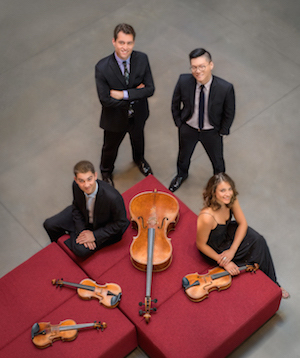
The Dover Quartet, an esteemed and active ensemble from Philadelphia, paid a return visit to the Trianon Theatre for a San José Chamber Music Society concert on Sunday, bearing two large and expansively-paced string quartets. Schubert’s final quartet in G major and Tchaikovsky’s Quartet No. 3 in E-flat Minor are each in four movements, running about three-quarters of an hour.
The Schubert is one of the acknowledged masterworks of the repertoire and could not possibly receive anything less than an exquisite performance from the Dover players. From the beginning, the evenly balanced ensemble opened up worlds of resonant sonority, immediately wrapping the listeners in such a spell that it was actively painful when the music suddenly ceased about two minutes in. Camden Shaw had to fix a problem with the endpin of his cello. He apologized for the vagaries of his instrument, and the magic resumed.
So blended was the sound of this music as to give the impression that Schubert wrote his quartet without any solo passages. Of course, that’s not true. But even in the prominent main theme of the Andante, Shaw was so careful and restrained in his playing that his sound did not outweigh the chordal accompaniment of the other three. In other passages where the cello merely carried the bass line, the instrument was equally prominent – or, equally, not prominent. It was separately audible where second violinist Bryan Lee and violist Milena Pajaro-van de Stadt consciously melded into the whole, but it did not obtrude itself.

First violinist Joel Link was even gentler and lighter in his playing. What would in another performance be violin solos were rendered here as a subtle texture, like swirls in a layer of cake frosting. Link’s decorations in the repeat of the first movement’s second theme were the ideal expression of this character.
The G Major Quartet has its harsh and dramatic parts, but compared with its D minor predecessor it’s a warm and affable work, and that is how it came across here. Nothing unduly jagged in the first two movements, no sense of relieved high spirits in the scherzo and finale, just some good, serious, fast music.

The Dover players used the same techniques on Tchaikovsky’s Quartet No. 3. To some extent it felt like a waste of these performers’ talents to expend them on a work that isn’t even top-drawer Tchaikovsky. But while the fast music had a routine quality made even more conspicuous by supremely dedicated and conscientious playing – a lighter and more whimsical approach might have suited it better – it quickly became clear that the value of this composition lay in its slow sections: the introductory Andante sostenuto of the first movement and the Andante funebre third movement.
The latter, in particular, shone here. Played muted, which gave a glassy sheen to the music, it consists in large part of a sequence of static chords in a slow marching rhythm. This was ideal for the Dover’s blended playing. In and out the music breathed, slowly. Stuttering patterns of repeating B-flats in Lee’s second violin between chord phrases lent a haunting quality to the proceedings.
A quick and disconcerting adjustment of the listeners’ ears was needed to turn from that to a piece of contemporary music, Mason Bates’s From Amber Frozen. This 15-minute piece begins with rhythmically and tonally irregular separated notes – many pizzicato, others bowed – from all over the quartet. These don’t coalesce, but gradually are replaced by metallic shivers and overlapping long-held phrases occupying a limited harmonic space. Then it returns to the broken-apart opening.
This work doesn’t have the striking appeal of Bates’s best music. But it is always well-constructed and interesting.
Correction: The original article stated that Mason Bates’s From Amber Frozen featured an electronic track, which it does not; the work is purely acoustic.




